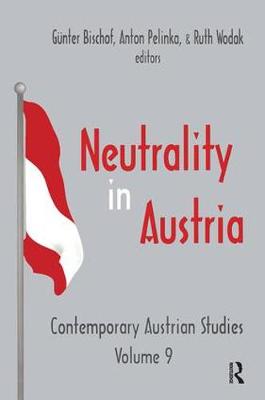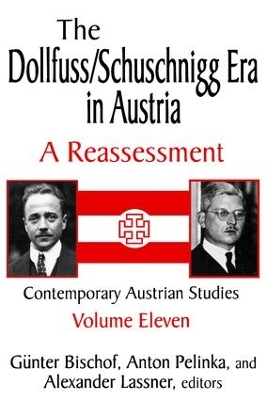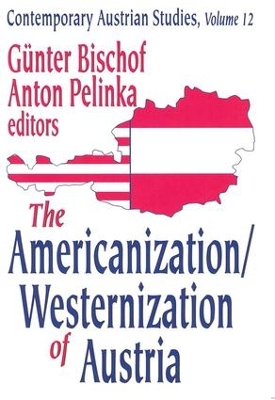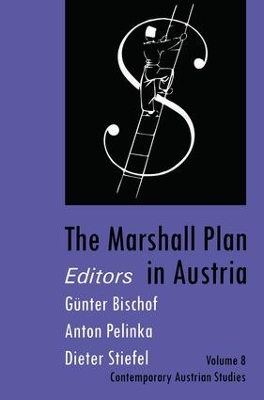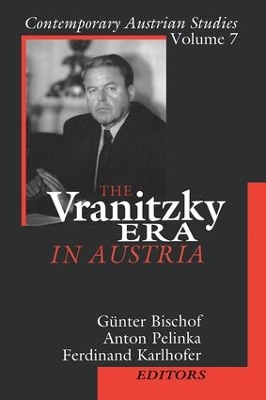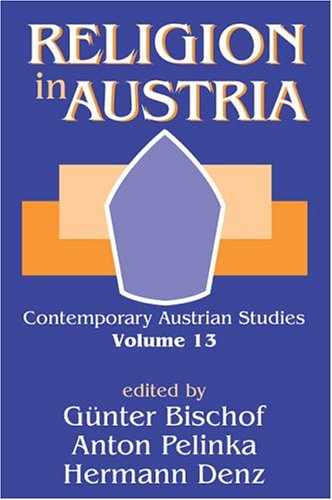Contemporary Austrian Studies
7 total works
After Stalin's death, during a respite in Cold War tensions in 1955, Austria managed to rid itself of a quadripartite occupation regime and become a neutral state. As the Cold War continued, Austria's policy of neutrality helped make this small country into an important mediator of East-West differences, and neutrality became a crucial part of Austria's postwar identity. In the post-Cold War era Austrian neutrality seems to demand redefinition. The work addresses such issues as what neutrality means when Austria's neighbors are joining NATO? What is the difference between Austrian neutrality in 1955 and 2000? In remaining apart from NATO, do Austrian elites risk their nation's national security? Is Austria a "free rider," too stingy to contribute to Western defense? Has the neutralist mentalit become such a crucial part of Austrian postwar identity that its abandonment will threaten civil society? These questions are addressed in this latest in the prestigious Contemporary Austrian Studies series.
The volume emerged from the Wittgenstein Research Center project on "Discourse, Politics, and Identity," an interdisciplinary investigation of the meaning of Austrian neutrality. The first two chapters analyze the current meaning of Austrian neutrality. Karin Liebhart records narrative interviews with former presidents Rudolf Kirchschlger and Kurt Waldheim, both central political actors present at the creation and implementation of Austria's postwar neutrality. Gertraud Benke and Ruth Wodak provide in-depth analysis of a debate on Austrian National Television on "NATO and Neutrality," a microcosm of Austrian popular opinion that exposed all positions and ideological preferences on neutrality. The historian Oliver Rathkolb surveys international perceptions of Austrian neutrality over the past half-century. For comparative contrast David Irwin and John Wilson apply Foucault's theoretical framework to the history and debates on neutrality in Ireland. Political scientists Heinz Grtner and Paul Luif provide examples of how Austrian neutrality has been handled in the past and today. Michael Gehler analyzes Austria's response to the Hungarian crisis of 1956 and Klaus Eisterer reviews the Austrian legation's handling of the 1968 Czechoslovak crisis.
Gnter Bischof is professor of history and executive director of Center Austria at the University of New Orleans. Anton Pelinka is professor of political science at the University of Innsbruck and director of the Institute of Conflict Research in Vienna. Ruth Wodak is professor in the linguistics department at the University of Vienna and director of the research center "Discourse, Politics, Identity" at the Austrian Academy of Science.
In 2005, Austria celebrated the sixtieth anniversary of its liberation from the Nazi regime and the fiftieth anniversary of the State Treaty that ended the occupation and returned full sovereignty to the country. This volume of Contemporary Austrian Studies covers foreign policy in the twentieth century. It offers an up-to-date status report of Austria's foreign policy trajectories and diplomatic options.Eva Nowotny, the current Austrian ambassador to the United States, introduces the volume with an analysis of the art and practice of Austrian diplomacy in historical perspective. Ambassador Wolfgang Petritsch analyzes recent Balkans diplomacy as an EU emissary in the Bosnian and Kosovo crises. Historians Gunther Kronenbitter, Alexander Lassner, Gunter Bischof, Joanna Granville, and Martin Kofler provide historical case studies of pre-and post-World War I and World War II Austrian diplomacy, Austria's dealings with the Hungarian crisis of 1956, and its mediation between Kennedy and Khrushchev in the early 1960s. Political scientists Romain Kirt, Stefan Mayer, and Gunther Hauser analyze small states' foreign policymaking in a globalizing world, Austrian federal states' separate regional policy initiatives abroad and Austria's role vis-a-vis current European security initiatives. Michael Gehler periodizes post-World War II Austrian foreign policy regimes and provides a valuable summary of both the available archival and printed diplomatic source collections. A "Historiography Roundtable" is dedicated to the Austrian Occupation decade. Gunter Bischof reports on the state of occupation historiography; Oliver Rathkolb on the historical memory of the occupation; Michael Gehler on the context of the German question; and Wolfgang Mueller and Norman Naimark on Stalin's Cold War and Soviet policies towards Austria during those years. Review essays and book reviews on art theft, anti-Semitism, the Hungarian crisis of 1956, among other topics, complete the volume.
The years of Chancellors Dollfuss and Schuschnigg's authoritarian governments (1933/34-1938) have been denounced as "Austrofascism" from the left, or defended as a Christian corporate state ("Stondestaat") from the right. During this period, Austria was in a desperate struggle to maintain its national independence vis-o-vis Hitler's Germany, a struggle that ultimately failed. In the end, the Nazis invaded and annexed Austria (Anschluss").
Volume 11 of the Contemporary Austrian Studies series stays away from these heated historiographical debates and looks at economic, domestic, and international politics sine ira et studio. Timothy Kirk opens with an assessment of "Austrofascism" in light of recent discourse on interwar European fascism. Three scholars from the Economics University of Vienna analyze the macroeconomic climate of the 1930s: Hansjrg Klausinger the "Vienna School's" theoretical contributions to end the "Great Depression"; Gerhard Senft the economic policies of the Stondestaat; and Peter Berger the financial aid from the League of Nations. Jens Wessels delves into the microeconomic arena and presents case studies of leading Austrian businesses and their performance during the depression. Jim Miller looks at Dollfuss, the agrarian reformer. Alexander Lassner and Erwin Schmidl deal with the context of the international arena and Austria's desperate search for protection against Nazi Anschluss-pressure and military preparedness against foreign aggression.
In a comparativist essay Megan Greene compares the policies of Austria's Haider and Italy's Berlusconi and recent EU responses to threats from the Right. The "FORUM" looks at various recent historical commissions in Austria dealing with Holocaust-era assets and their efforts to provide restitution to victims of Nazism. Two review essays, by Evan Burr Bukey and Hermann Freudenberger, survey recent scholarly literature on Austria(ns) during World War II. This addition to the Contemporary Austrian Studies series will be welcomed by political scientists, historians and scholars with a strong interest in European affairs.
Political, economic, social, and cultural modernization dramatically transformed twentieth-century Austria. Innovative new methods of production and management, such as the assembly line, changed Austrian business after World War I, much as the Marshall Plan shaped the economy after World War II. At the same time, jazz, Hollywood movies, television programming, and mass commodities were as popular in Austria as elsewhere in Western Europe. Even political campaigns followed American trends. All this occurred despite the fact that in West Germany, American nostrums and models had been rejected, modified, or "translated" into milder versions. Ultimately, Austria was "Western Europeanized" when it joined the European Union in 1995. How Western are the Austrians? This volume analyzes trends toward Americanization and Westernization in Austria throughout the twentieth century. Reinhold Wagnleitner's lead essay studies the foreign politics of American pop culture.
Anna Schober and Monika Bernold analyze the influence of Hollywood movies and television on postwar Austrian society. Reinhard Sieder follows changing discourses on family life, while Ingrid Bauer looks at American influences on Austrian women. Maria-Regina Kecht, Kurt Drexel, and Christina Hainzl follow the American impact on Austrian literature, opera, and art. Banker Anton Fink examines American banking and finance practices. Andre Pfoertner and Matthias Fuchs study the Americanization of Austrian business and tourism. Helmut Lackner describes how well-heeled Austrian travelers to the United States brought back innovative American production methods and other ideas gleaned from world expositions before World War I. American influences on Austrian politics and political science are dissected by Gunter Bischof, Martin Kofler, Fritz Plasser, and Anton Pelinka. The Americanization of Vienna is the subject of journalist Armin Thurnher's essay. Comparisons with West Germany are presented by Michael Hochgeschwender. These essays prove that "Americanization," "Westernization," and "globalization" need to be carefully defined before generalizations can be made.
Perhaps no country benefitted more from the Marshall Plan for assistance in reconstruction of Europe after World War II than Austria. On a per capita basis, each American taxpayer invested $80 per person in the Plan; each Austrian received $133 from the European recovery program, more than any other of the sixteen participating countries. Without the Marshall Plan, the Austrian economic miracle of the 1950s would have been unthinkable. Despite this, contemporary Austria seems to have forgotten this essential American contribution to its postwar reconstruction. This volume in the Contemporary Austrian Studies series examines how the plan affected Austria, and how it is perceived today.The political context of the Marshall Plan in Austria is addressed in essays by Jill Lewis and Matthew Berg. Dieter Stiefer describes the vast Soviet economic exploitation of their Austrian occupation zone. Andrea Komlosy shows how the Marshall Plan helped complete the division of Europe. Siegfried Beer suggests the secret involvement of the CIA in the Marshall Plan, while Hans J³rgen Schr÷der analyzes the effectiveness of Marshall Plan propaganda programs in Germany and Austria.The macroeconomic impact of Marshall Plan funds on Austrian economic policy is outlined by Hans Seidel. Kurt Tweraser, Georg Rigele and G³nter Bischof suggest the microeconomic importance of funds for the steel, electricity and tourist sectors of the Austrian economy. Wilhelm Kohler's sweeping analysis compares the American transfer of funds to postwar Europe with current debates about the cost of European Union enlargement. The legacy of the Marshall Plan is addressed by former Austrian Finance Minister Ferdinand Lacina. Kurt Loffler and Hans Fubenegger summarize the activities of the Economic Recovery Program Fund. Coming on the heels of the fiftieth anniversary of the Marshall Plan, this compelling overview of the Plan and its impact will be important for historians, those interested in international politics, and Austrian scholars.G³nter Bischof is professor of history and associate director of Center-Austria at the University of New Orleans; Anton Pelinka is professor of political science at the University of Innsbruck and director of the Institute of Conflict Research in Vienna; Dieter Stiefel is professor of social and economic history at the University of Vienna and executive secretary of the Schumpeter Society in Vienna.This volume offers a collection of articles, mostly by contemporary Austrian-born historians, touching on various phases of the Marshall Plan administered through the European Recovery Program (ERP) and its successors counterfunds' assistance to the present. A splendid introduction followed by the key thirteen articles on the plan is augmented by several nontopical essays and book reviews, along with a survey of Austrian politics in 1998. A number of articles emanated from a 1998 conference at the University of New Orleans. Both novice and specialist will appreciate this book."-The Historian
Franz Vranitzky, the banker turned politician, was chancellor during the ten years (1986-96) when the world dramatically changed in the aftermath of the cold war. Among postwar chancellors, only Bruno Kreisky held office longer. The Austrian Social Democratic Party has been in power since 1970. Such longevity is unique in postwar European politics. The dominance of Social Democracy in particular is noteworthy when compared to the general decline of traditional leftist politics in Europe. The chapters in this volume try to assess Vranitzky's central role in recent Austrian and European history.
Richard Luther presents the general European political context in which Vranitzky operated. Eva Nowotny, Vranitzky's former principal foreign policy adviser and Austria's current ambassador to the United Kingdom, analyzes his struggle over joining the European Union as well as Austria's security dilemmas following the cold war. Fritz Plasser looks at the changing electoral behavior of Austrians and the ascendancy of new parties. Irene Etzerdorfer concentrates on the long hegemony of Austrian Social Democratic leadership by comparing Vranitzky's and Kreisky's leadership styles. Other contributors include Sonja Puntscher-Riekmann, Brigitte Unger, Peter Rosner, Alexander van der Bellen, and George Winkler.
A forum on postwar Austrian memory of World War II from a comparative perspective, which continues the theme of previous volumes in this series, is also included. Jonathan Petropoulos demonstrates how Swiss middlemen were in the center of dealing with stolen Nazi art during and after the war, while Olive Rathkolb describes the shameful legacy of the Austrian government's procrastination in resolving the issue of Jewish "heirless art." Peter Utgaard shows how in Austria's postwar high school textbooks the American bombing of Hiroshima often figured more prominently than the Holocaust. Review essays and book reviews complete the volume. The Vranitzky Era in Austria is a compelling work for political scientists, historians, and Austria studies scholars.
Gnter Bischof is associate director of Center Austria and associate professor of history at the University of New Orleans, and former visiting professor at the University of Salzburg.
Anton Pelinka is director of the Austrian Institute of Conflict Research in Vienna, professor of political science at the University of Innsbruck, and former visiting professor at Stanford University.
Ferdinand Karlhofer is associate professor of political science at the University of Innsbruck and former visiting professor at the University of New Orleans.
Like most European countries, Austria does not have a strict separation between state and church. Since the counter-reformation, it has been considered a country strongly influenced by Catholicism. Austrian attitudes towards religion derive from the Habsburg experience, when Austria's emperors and the Catholic Church acted in complete unison. This new volume in the Contemporary Austrian Studies series reevaluates this age-old tradition.
Religion in Austria focuses on relationships between political parties and religious faiths. Individual chapters analyze the impact of religion on contemporary Austria. They explore the post-World War II decline--perhaps even the demise--of political Catholicism in the Second Republic; the political pluralism, which the still-dominant Catholic Church had to become accustomed to; and the principle of religious tolerance all major political parties have learned to accept. Contributors discuss the different formal (legal) links between the privileged denominations (the Catholic Church and other Christian churches, Islam, Judaism, Buddhism) and the state, especially in the areas of education and public finance.
Particular emphasis is given to the two traditional Christian churches--the Roman Catholic and the Protestant (Lutherans and Reformists)--as well as to the fastest growing new denominations, Islam and Judaism. Since a growing number of Austrians declare themselves to be officially not affiliated with any of the denominations in this age of secularism, the phenomenon of the Konfessionslosen (persons without religious affiliation) is also examined.
This volume presents different approaches to the changing trajectory of religious practice in Austria, including contemporary history, political science, sociology, and law. It will be of interest to sociologists, historians, and students of religion.
Gnter Bischof is the 2003/4 Marshall Plan Anniversary Professor of Austrian Studies and the director of CenterAustria at the University of New Orleans.
Anton Pelinka is professor of political science at the University of Innsbruck and the director of the Institute of Conflict Research in Vienna
Hermann Denz is professor of sociology at the University of Innsbruck in Austria.
